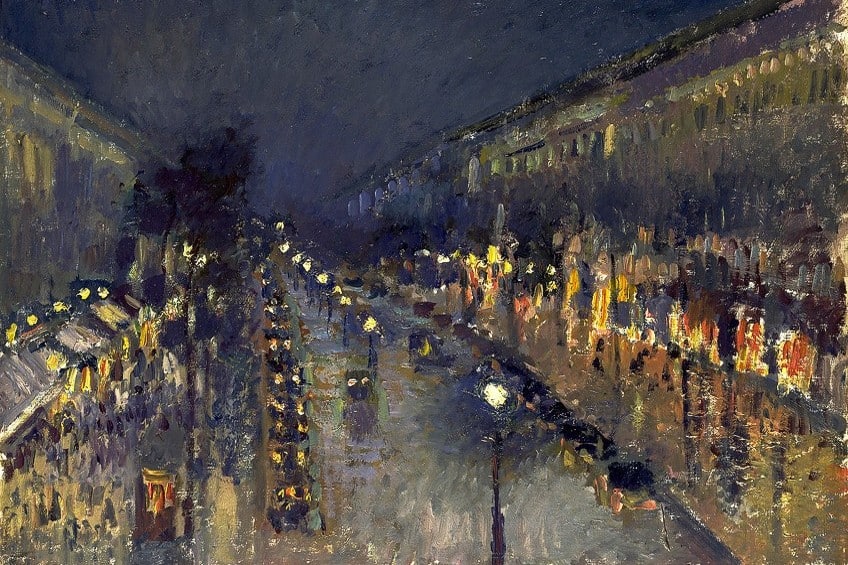Famous French Painters and Paintings – The Top Parisian Painters
Paris has been the Mecca of art for many centuries and is a rite of passage for any artist or art lover. This article will take you through a reminiscent exploration of some of the most famous French painters and paintings of all time, including popular French painters of the 19th century.
Top 15 Most Famous French Painters and Paintings
France was the birthplace of many of the 18th- and 19th-century Western art masters who provided us with some of the most famous French paintings. French rulers like Louis XIII and Louis XIV also aided in the efforts to promote French artistic development by assisting in the establishment of the French Academy of Fine Art.
The academy and the culture around art in France allowed for the emergence of many artistic revolutions and art movements, including Neoclassicism, Romanticism, Realism, and the French Baroque style.
France later saw the rise of Impressionism followed by post-Impressionism, which can be considered as two of the supporting pillars of Modernism. Below, we will take a look at the top 15 most famous French painters and paintings of all time.
Jacques-Louis David (1748 – 1825)
| Artist Name | Jacques-Louis David |
| Date of Birth | 30 August 1748 |
| Date of Death | 29 December 1825 |
| Movements, themes, styles | Neoclassicism, history painting, Late Baroque |
Jacques-Louis David is regarded as the pioneer of Neoclassicism and one of the most famous French artists of the 18th century and also a keen supporter of the French Revolution. Dubbed a “dictator of the arts”, David was also active in developing his painting style and transitioned from Neoclassicism and Rococo styles to the Empire style, characterized by rich Venetian colors.
Neoclassicism was informed by classical antiquity and originated in Rome.
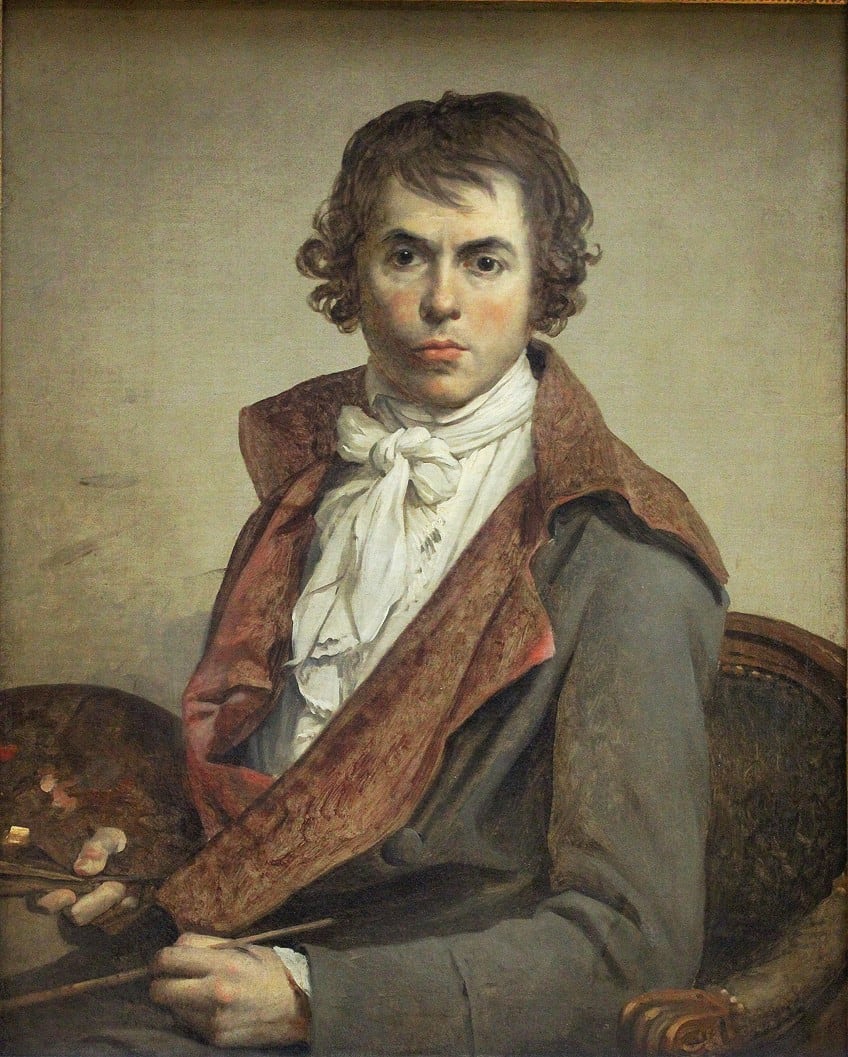
The Neoclassical style emerged in European art history as a revolt against the Rococo style, which was defined by its ornate architectural decor and a combination of art, design, asymmetry, and embellishment. David was also a hit sensation at the famous Salon where he showcased his refined and balanced depictions of classical subjects. David was closely acquainted with Maximilien Robespierre, a French statesman, and lawyer, who was also a member of high controversy surrounding the French Revolution.
When Napoleon took over, David realigned his style to suit the aesthetic of the new regime.
Oath of the Horatii (1784)
| Date | 1784 |
| Medium | Oil on canvas |
| Dimensions (cm) | 329.8 x 424.8 |
| Where It Is Housed | Louvre Museum, Paris, France |
This famous French painting by David is known as the paragon of Neoclassical art and is one of the artist’s works that boosted his rise to fame. The painting depicts the 7th-century Roman narrative of a dispute between two cities, Alba Longa and Rome. The theme of the painting centers around the masculine stereotype of a self-sacrificial act for one’s country and is a display of man’s patriotism.
Instead of employing mass amounts of soldiers from each city, the story described the event as both cities choosing three men to represent each city and the winner of the fight would be the winner on behalf of the city.

The Horatii, as mentioned in the title, was a Roman family and the brothers who represented Rome in the story. The painting shows the men saluting their father as they take their battle swords from him. Of the trio, only one would survive and it was the surviving brother who succeeded in killing the representatives of Alba Longa.
David also includes in the bottom right section of the painting a seated woman crying in sorrow.
This woman is Camilla, who was the sister of the Horatii brothers but the plot twist was that she was betrothed to one of the opposing fighters and this scene illustrates her realization that no matter the outcome of the fight, she was the one losing someone she loved. In the tragic aftermath, the victorious brother, Publius, killed Camilla for crying over the enemy. David’s painting also resulted in the popularization of the Roman salute and a career boost when he began acquiring his students.
Eugène Delacroix (1798 – 1863)
| Artist Name | Ferdinand Victor Eugène Delacroix |
| Date of Birth | 26 April 1798 |
| Date of Death | 13 August 1863 |
| Movements, themes, styles | Romanticism |
Ferdinand Victor Eugène Delacroix is regarded as the leader of the French Romantic school who drew his inspiration from artists like Sir Peter Paul Rubens and Venetian Renaissance styles. His work was described as individualistic and was also inspired by Lord Byron, who he greatly admired and found a connection with through ideas around the sublime expressed in violent action and nature. As a leading French master of Romanticism in painting, Delacroix was drawn to themes that allowed him to express romantic and dramatic scenes.
This fueled his desire to travel to North Africa where he found comfort in the culture and what Western artists viewed as “exotic”.

Delacroix frequently used expressive brush strokes and created optical effects using color, which later inspired the work of many Impressionists. His passion for the exotic inspired the emergence of the Symbolist movement, which was a 19th-century movement across poetry, literature, and other arts to express absolute truth via symbolic means and metaphorical visual imagery.
Delacroix is also famous for creating many lithographic illustrations for famous literature moguls like Walter Scott, William Shakespeare, and Johann Wolfgang von Goethe.
Liberty Leading the People (1830)
| Date | 1830 |
| Medium | Oil on canvas |
| Dimensions (cm) | 260 x 325 |
| Where It Is Housed | Louvre Museum, Paris, France |
Liberty Leading the People (1830) is Delacroix’s most famous painting and one of French art history’s most iconic paintings. The scene portrayed here is a commemoration of the 1830 July Revolution that toppled King Charles X. The concept of liberty is represented by the woman in the Phrygian cap who leads a bunch of people over a barricade while trampling on the bodies of the fallen.
The woman also holds the flag of the French Revolution in the air with the tricolor that soon became the national flag of France. In the woman’s other hand, one can see a bayoneted musket.

Liberty is seen as a symbol of France itself, Marianne, or the French Republic. This painting is often confused as a depiction of the French Revolution, which occurred before this battle in 1789. The painting was opened to the public eye at the 1831 Salon and it was acquired by the French government in the same year for 3,000 francs. In 1874, the painting was moved to the collection of the Louvre in Paris.
The painting is also said to have influenced the famous 1862 novel Les Misérables by Victor Hugo.
Gustave Courbet (1819 – 1877)
| Artist Name | Jean Désiré Gustave Courbet |
| Date of Birth | 10 June 1819 |
| Date of Death | 31 December 1877 |
| Movements, themes, styles | Realism |
A champion of the Realism art movement, Gustave Courbet was one of the most revolutionary French painters of the 19th century who rejected academic conventions and the ideals of Romanticism. His independent thinking is what further spurred the already growing rejection soon to be expressed by the Impressionists and the Cubists.
His innovative approach to painting allowed him to express bold social statements.

Courbet first received attention between 1840 and 1850 for his works that went against traditional depictions of peasants and laborers. As a painter, his subject matter was not as politically charged as his predecessors as he explored painting seascapes, landscapes, nudes, still lifes, and hunting scenes. Although his paintings did not show his political rigor, he was known to be a socialist and was very active in French politics.
In 1871, Courbet was sent to prison for six months for his participation in the Paris Commune and then exiled to Switzerland in 1873, where he died four years later.
The Painter’s Studio: A Real Allegory Summing up Seven Years of my Artistic and Moral Life (1855)
| Date | 1855 |
| Medium | Oil on canvas |
| Dimensions (cm) | 361 x 598 |
| Where It Is Housed | Musée d’Orsay, Paris, France |
This famous French painting by Courbet is currently housed at the Musée d’Orsay and is said to serve as an allegory for the different influences that Courbet used in his artistic career. On the left of this large work are people from different levels in French society. In the center, Courbet painted himself working on a landscape painting while ignoring the figure of the nude woman who is symbolic of the ideals of academic art. The right side of the painting shows Courbet’s friends and acquaintances, who were often elite members of Parisian society.
His friends included Charles Baudelaire, Alfred Bruyas, Champfleury, and Pierre-Joseph Proudhon.

Unfortunately, this painting was rejected by the 1855 Paris World Fair although they accepted 11 other works by Courbet. Courbet wanted the work to receive the exposure it deserved and held his exhibition with the help of his patron, Alfred Bruyas, which predated the famous Salon des Refusés. Among his supporters for the painting was Eugène Delacroix.
According to Courbet, the painting was also a representation of society at its “best, worst, and average”.
Camille Pissarro (1830 – 1903)
| Artist Name | Jacob Abraham Camille Pissarro |
| Date of Birth | 10 July 1830 |
| Date of Death | 13 November 1903 |
| Movements, themes, styles | Impressionism, Neo-Impressionism |
Camille Pissarro is best known as the pillar and father figure of the French Impressionists. The Danish-French painter was also a Neo-Impressionist who is well-known for his contributions towards Impressionism and post-Impressionism. Pissarro was also a great admirer of Gustave Courbet’s work and was a key figure in the group of aspiring Impressionist society in 1873. According to Pierre-Auguste Renoir, Pissarro’s work was revolutionary for his depiction of the common man.
Pissarro often painted people in natural environments without any Romanticism or grandeur. Pissarro was to later influence other great artists like Vincent van Gogh and Paul Cézanne.
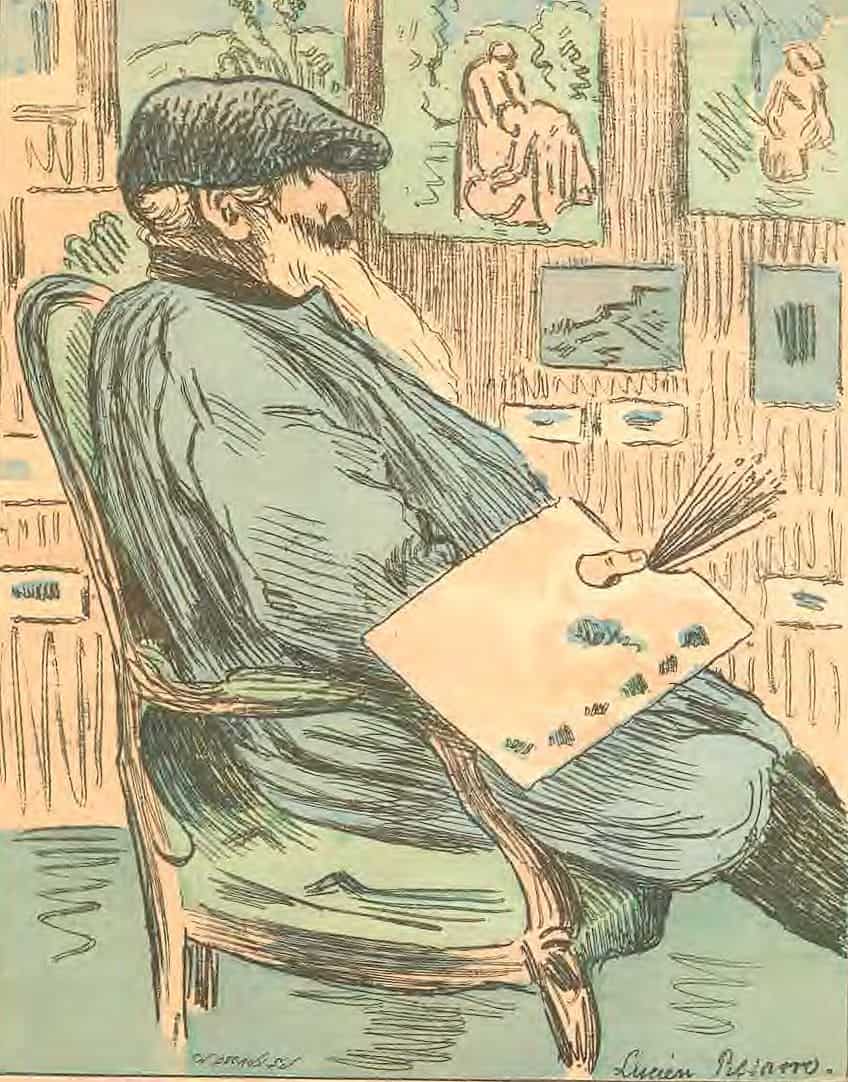
The Boulevard Montmartre at Night (1897)
| Date | 1897 |
| Medium | Oil on canvas |
| Dimensions (cm) | 53.3 x 64.8 |
| Where It Is Housed | The National Gallery, London |
The Boulevard Montmartre at Night (1897) is one of the most famous French paintings by Pissarro, which depicts an evening in Paris with all of the usual street features. At the time, Paris was the hub of European architecture following a city-wide reconstruction by Baron Georges-Eugène Haussmann. Toward the end of his life, Pissarro focused heavily on depictions of Parisian scenery and scenes from Le Havre, London, and Rouen.
He often painted from the windows of different apartments and hotels.
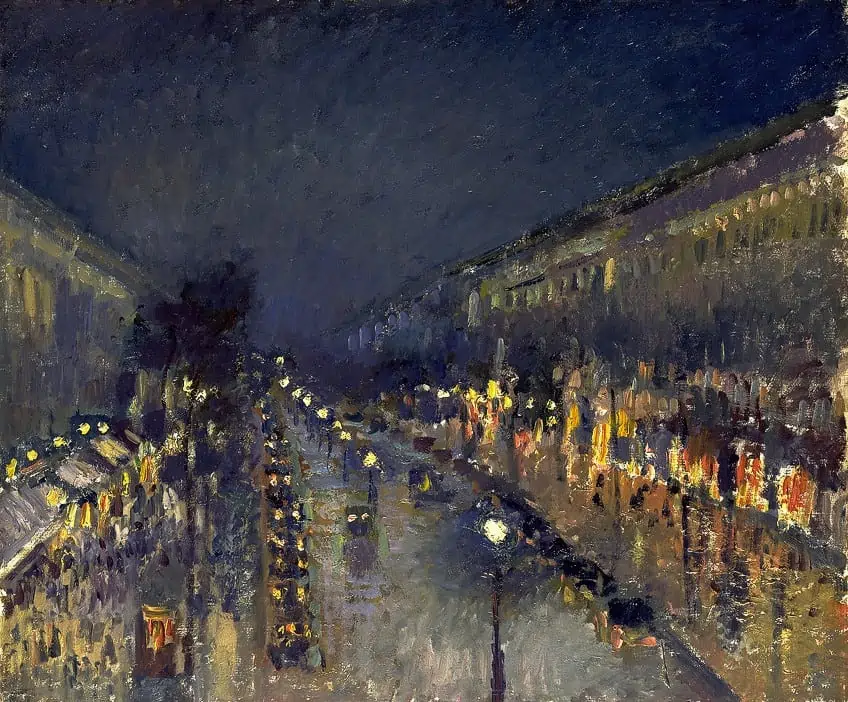
This painting was painted from a room at the Hôtel de Russie on the corner of Boulevard des Italiens. Here, he created a series of paintings depicting the Boulevard Montmartre and it is said that Pissarro was most likely influenced by Claude Monet and Édouard Manet who also used a similar approach. Pissarro showcases in this painting his excellence in painting light as he combines the light of the streets with the darkness and wetness of the streets.
This was one of the paintings that Pissarro never exhibited during his lifetime.
Édouard Manet (1832 – 1883)
| Artist Name | Édouard Manet |
| Date of Birth | 23 January 1832 |
| Date of Death | 30 April 1883 |
| Movements, themes, styles | Impressionism, Modernism, Realism, Modern art |
Perhaps one of the most controversial French Modernist artists of his time, Édouard Manet, spared no time in expressing his artistic inclination and rejection of academic art ideals. Manet is most famous for many paintings that shocked members of the Salon and led him to join the Impressionists for a short period. Manet is known for being a leader in the transition of Realist painting to Impressionism and can be considered an early pioneer of Modernism.
Among his best paintings are two 1863 works, Le déjeuner sur l’herbe and Olympia.
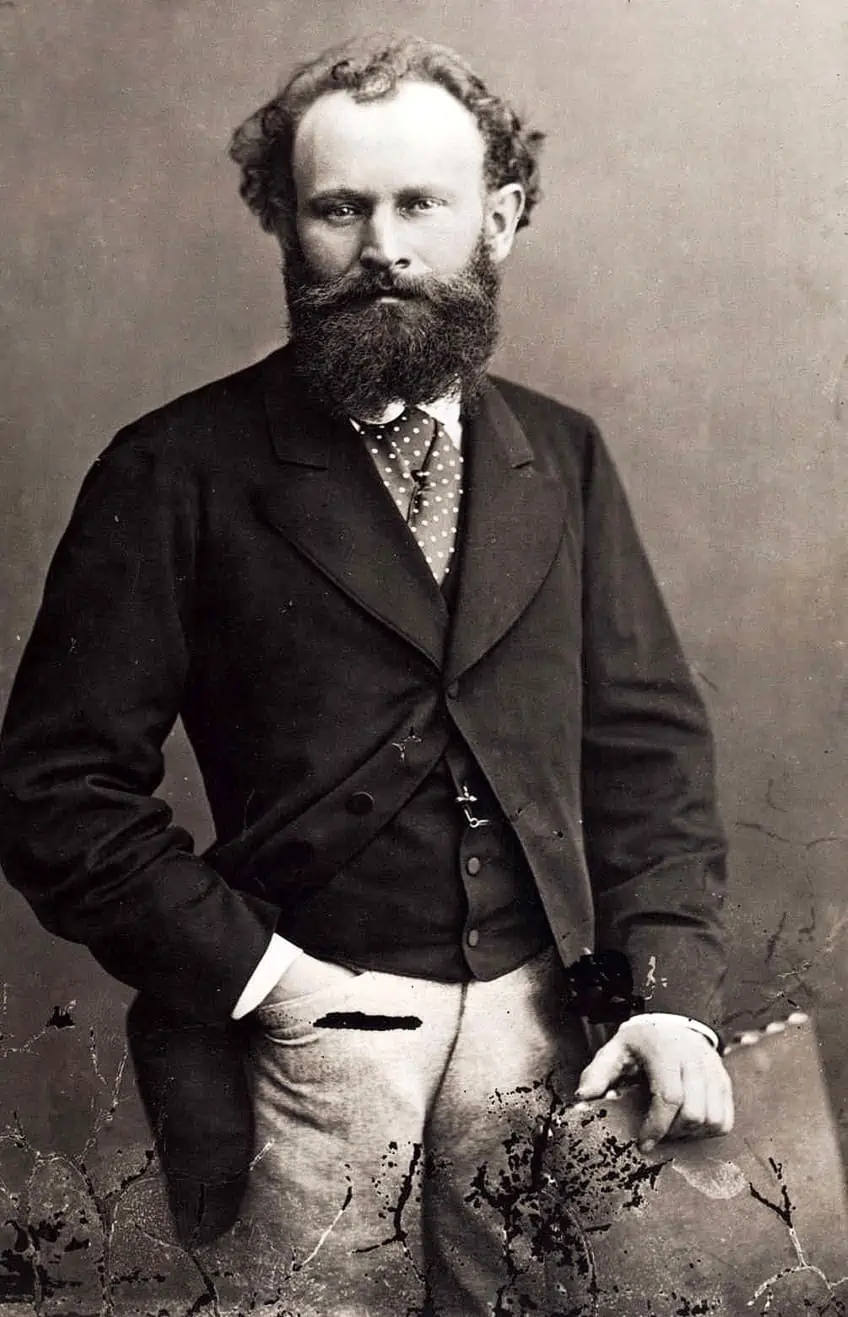
Le déjeuner sur l’herbe (1863)
| Date | 1863 |
| Medium | Oil on canvas |
| Dimensions (cm) | 208 x 264.5 |
| Where It Is Housed | Musée d’Orsay, Paris, France |
Also called Le Bain and Luncheon on the Grass, this famous 1863 painting is anything but just a casual picnic on the grass. Manet’s presentation of this painting for consideration into the Salon was considered “vulgar” and outright shocking due to his contemporary subject matter of portraying a nude woman staring at the viewer as she lounges in a picnic on the grass with two fully-clothed men.
Manet used a large canvas, which was traditionally reserved for historical paintings and mythological scenes. This French painting is famous for being one of Manet’s most defiant and harshly criticized paintings.

Edgar Degas (1834 – 1917)
| Artist Name | Hilaire-Germain-Edgar Degas |
| Date of Birth | 19 July 1834 |
| Date of Death | 27 September 1917 |
| Movements, themes, styles | Impressionism, Realism |
This Parisian painter, Edgar Degas, was a famous French Impressionist who also considered himself to be a Realist. Degas is incredibly famous for his mastery of pastels and oil painting, often depicting scenes of dancers, rehearsals, portraiture, and movement. He also painted subjects such as racehorses and bathing women. Although he initially wanted to become a painter of history, Degas eventually fell to the charm of Impressionism as a way to explore his interests.
He soon went on to become one of the greatest French classical painters of contemporary Parisian life.
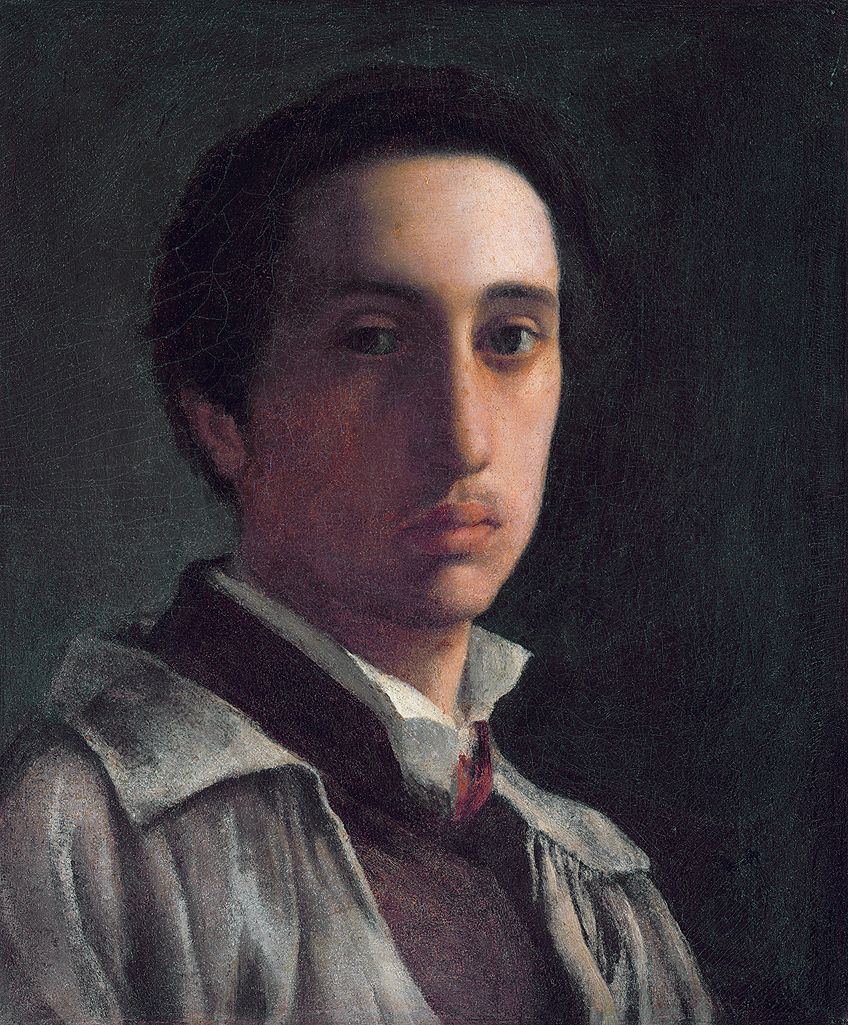
The Ballet Class (1871 – 1874)
| Date | 1871 – 1874 |
| Medium | Oil on canvas |
| Dimensions (cm) | 75 x 85 |
| Where It Is Housed | Musée d’Orsay, Paris, France |
The Ballet Class is one of the most famous French paintings of the 19th century by Edgar Degas that illustrates one of his favorite subjects, the rehearsal rooms of ballet dancers. The painting shows a vast studio with the ballet master holding a baton in the direction of the vanishing point of the studio. The scene shows the end of a ballet class with the many exhausted ballet dancers around the room.
Degas was a frequent visitor of the Paris opera house and took a keen interest in the lives of ballet dancers and their ability to move their bodies in such a strenuous manner.

Paul Cézanne (1839 – 1906)
| Artist Name | Paul Cézanne |
| Date of Birth | 19 January 1839 |
| Date of Death | 22 October 1906 |
| Movements, themes, styles | Impressionism, Post-Impressionism, Cubism, Modern Art |
Famous for connecting the gap between the 19th-century post-Impressionist style and the 20th-century Cubist style, Paul Cézanne made a profound impact on the art scene of France. Influenced by some Romanticism and Realism, Cézanne strove towards a transformation of the traditional methods of design in conjunction with the Impressionist use of color modulation and space. Cézanne often displayed the use of visible brush strokes in a repetitive manner combined with different color planes and smaller brush strokes to create complex fields.
His use of color and execution of painting style resulted in paintings showing his intense focus on the subject. Even Henri Matisse and Pablo Picasso claimed that Cézanne was the “father” of them all.

The Large Bathers (1900 – 1906)
| Date | 1900 – 1906 |
| Medium | Oil on canvas |
| Dimensions (m) | 2.1 x 2.51 |
| Where It Is Housed | Philadelphia Museum of Art, Philadelphia |
The Large Bathers (1900-1906) is one of Cézanne’s largest paintings in his career and showcases his exploration of the nude body within a landscape. Often considered unfinished, the painting garnered much attention during its prime and was even admired by Paul Gauguin.
Cézanne considered the painting a piece that would be “like art in the museums” suggesting that the painting possessed a rather attractive timeless quality, which today, proved true.

Marie Bracquemond (1840 – 1916)
| Artist Name | Marie Bracquemond |
| Date of Birth | 1 December 1840 |
| Date of Death | 17 January 1916 |
| Associated Movements | Impressionism |
Marie Bracquemond was also part of the group of French Impressionists and was considered to be one of les trois grandes dames of Impressionism. Her omission from many historical accounts was due to her husband, Félix Bracquemond, who strongly disapproved of the Impressionists and their work and often belittled his wife’s work.
Bracquemond created around 156 artworks throughout her lifetime, however, only 31 remain in various collections today with the rest lost to other private collectors with no record.

The Lady in White (1880)
| Date | 1880 |
| Medium | Oil on canvas |
| Dimensions (m) | 180.5 cm x 105 |
| Where It Is Housed | Musée d’Orsay, Paris, France |
The Lady in White is one of Bracquemond’s most well-known works painted in 1880 and depicts the artist’s stepsister Louis Quioron who modeled for many of Bracquemond’s paintings. This painting was shown at the Impressionist’s fifth group show and is an example of Bracquemond’s mastery over Plein-air painting, which was the defining art style of Impressionism.
Bracquemond portrays her half-sister using subdued colors and often studied the way that the outdoor environment affected the color of her paintings.

The painting was acquired by the Musée du Luxembourg in 1919 and was exhibited from 1929 until 2019 when it was acquired by the Musée d’Orsay. What made Bracquemond stand out from the crowd of Impressionists was that she spent more time organizing and planning for her artworks than the rest of her contemporaries.
Her paintings were well thought out despite their spontaneous appearance.
Claude Monet (1840 – 1926)
| Artist Name | Oscar-Claude Monet |
| Date of Birth | 14 November 1840 |
| Date of Death | 5 December 1926 |
| Associated Movements | Impressionism |
Born in 1840 in Rue Laffitte, this famous Parisian painter and founder of the French Impressionist movement, Claude Monet, is one of the most famous French artists in history. Monet is most famous for his paintings of landscapes, executed in the traditional Impressionist en Plein air style, and his series of water lilies.
The French pioneer was one of the first artists to paint the world around him as he saw it, through the changing of seasons and the remarkable qualities of light.

Nymphéas Series (1897 – 1926)
| Date | 1897 – 1926 |
| Number in Series | 250 |
| Medium | Oil on canvas |
| Dimensions (cm) | Varied |
| Where It Is Housed | Multiple art institutions, including Rome, Paris, New York, Japan, New Jersey, Moscow, Cairo, London, Boston, Washington D. C., Ohio, Chicago, and other private collections. |
Nymphéas, also known as Monet’s Water Lilies series, is a series of 250 Impressionist paintings created during the artist’s last 30 years of his life that depict scenes from his precious flower garden at his home in Giverny. Monet suffered from cataracts, which distorted his perception of light and color in general and resulted in some of the most beautiful and famous French paintings of the water in the pond and the lilies.
The image of the bridge over the pond is also an iconic subject of this series with his largest painting made up of three panels, each measuring 200 x 424.8 centimeters, and housed at the Museum of Modern Art.

Berthe Morisot (1841 – 1895)
| Artist Name | Berthe Marie Pauline Morisot |
| Date of Birth | 14 January 1841 |
| Date of Death | 2 March 1895 |
| Associated Movements | Impressionism |
Berthe Morisot is among the noteworthy French Impressionist painters of the 19th century whose work reflects the gentleness of her passion for watercolor painting. Initially, Morisot struggled to grasp the handle on oil paint but with time, she managed to combine her skill in watercolor with her newfound medium of oil. Morisot soon began working in oil, pastel, and watercolor, which resulted in some of the most beautiful French paintings to date.
Most of her paintings also reflect an increased complexity in the interaction between figures and the integration of a visual approach via clear-cut lines, which made her work stand out.

Woman at Her Toilette (1875 – 1880)
| Date | 1875 – 1880 |
| Medium | Oil on canvas |
| Dimensions (cm) | 60.3 x 80.4 |
| Where It Is Housed | The Art Institute of Chicago |
This painting by Morisot presents an intimate view into the life of a young and seemingly, fashion-conscious young woman styling her hair in front of her mirror. Morisot exquisitely captures the subject through her feathered brushwork that draws out the sketch-like quality of the Impressionist’s work.
The wall in the background is rendered in an abstract manner with only brief brushstrokes to capture the wall’s designs.

Morisot’s signature can also be found on the frame of the mirror and may hint at the impermanence of the moment that she captured, which can also be seen in her brushwork and preference for a lighter color scheme. The painting was showcased at the Impressionist’s fifth exhibition in 1880 and bore some similarities to the 1876 painting, Before the Mirror by her brother-in-law Édouard Manet, which was shown at an exhibition in the same year.
Mary Stevenson Cassatt (1844 – 1926)
| Artist Name | Mary Stevenson Cassatt |
| Date of Birth | 22 May 1844 |
| Date of Death | 14 June 1926 |
| Associated Movements | American Impressionism, Modern art, Impressionism |
Mary Stevenson Cassatt is among the best painters of the American and French Impressionist movements. Although not French, Cassatt was incredibly involved in the Parisian art scene and achieved much fame and international success during her lifetime.
Born in Pennsylvania, Cassatt soon relocated to France where she spent the majority of her career with the French Impressionists and lifelong friend, Edgar Degas.

Some of Cassatt’s themes feature the intimacy between mother and child as well as the private and social lives of women. Cassatt was also strongly opposed to the Salon, which made the conditions difficult for female artists to put forward their work. The artist also played an important role in defining the “new woman”, which was part of the 1840s increasing wave of feminism.
This emphasized new ways of viewing the modern woman as intelligent and socially active.
Little Girl in a Blue Armchair (1878)
| Date | 1878 |
| Medium | Oil on canvas |
| Dimensions (cm) | 129.8 x 89.5 |
| Where It Is Housed | National Gallery of Art, Washington D.C |
Dubbed as Cassatt’s ‘’first real stunner”, Little Girl in a Blue Armchair is one of the artist’s most recognized artworks that illustrate not only another lens into childhood but also her talent in painting with the predominant color of turquoise blue that immediately captures the attention of the viewer. Degas also influenced many elements of this painting and helped Cassatt secure the model and inspire her then-existing interest in Japanese prints.
Cassatt faced much rejection during her career in France until she joined the Impressionists and collaborated with Degas to boost her artistic development.
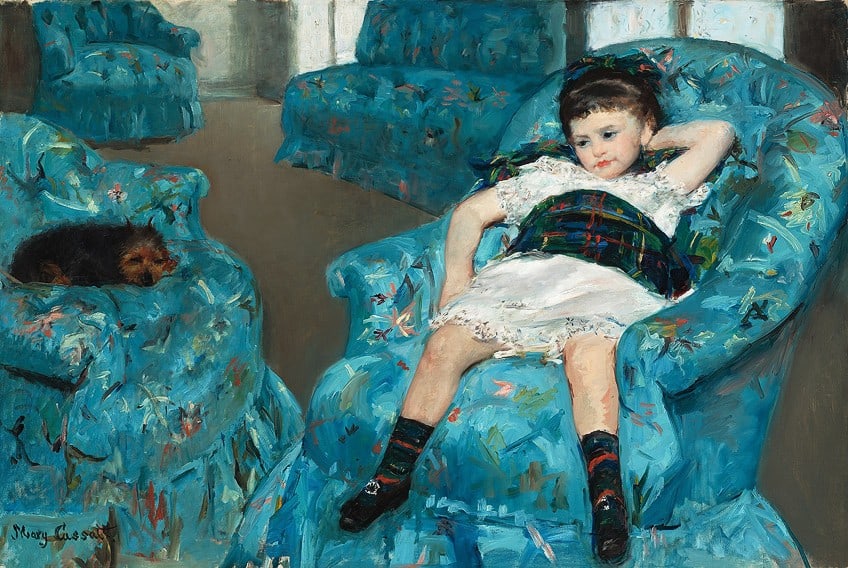
Paul Gauguin (1848 – 1903)
| Artist Name | Eugène Henri Paul Gauguin |
| Date of Birth | 07 June 1848 |
| Date of Death | 08 May 1903 |
| Movements, themes, styles | Post-Impressionism, Primitivism, Synthetism |
One of the post-Impressionists who only peaked in fame after death is Paul Gauguin, recognized for his experimental use of color and paintings from his trip to French Polynesia. Gauguin had more of an impact on the avant-garde scene and influenced many artists such as Vincent van Gogh, Henri Matisse, and Pablo Picasso.
Gauguin’s art rose to prominence after his death with the help of an art dealer, Ambroise Vollard, who held exhibitions for the late Gauguin in Paris.

Another movement that Paul Gauguin held great influence over was the Symbolist movement. Through his paintings, Gauguin incorporated the Cloisonnism style, which transitioned into Primitivism and back to the pastoral style.
Where Do We Come From? What Are We? Where Are We Going? (1897 – 1898)
| Date | 1897 – 1898 |
| Medium | Oil on canvas |
| Dimensions (cm) | 139 x 375 |
| Where It Is Housed | Museum of Fine Arts, Boston |
A classic example of Gauguin’s post-Impressionist style painting, Where Do We Come From? What Are We? Where Are We Going? (1897-1898) is a perfect display of Gauguin’s use of vivid colors to depict an emotionally-charged landscape painting that reflects the themes of the title itself. The painting was created alongside other emerging art movements such as Cubism and Fauvism of the early 20th century and portrays three women, a sleeping child, another group of people in the middle, and an older woman on the far left of the painting.
It was suggested that the composition is a reference to the cycle of birth, sin, and eventually death.
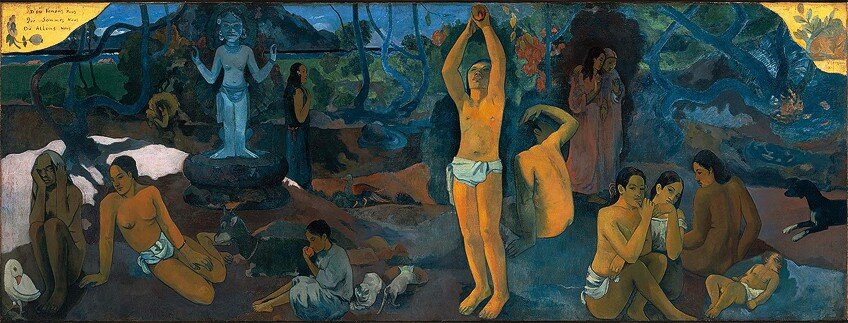
An image of the “beyond” as Gauguin pointed out is represented in the blue idol in the background, which exists outside the cycle of life. The three crouched figures and resting child represent the beginning of life while the middle group represents young adulthood.
The old woman who seems to be near her deathbed is painted as resigned to her last thoughts while a white bird at her feet serves as a symbol of the futility of words.
The figure in the middle is painted similarly to a motif seen in many depictions of the Garden of Eden and becomes an allegory of Eve and a representation of sin as she picks the fruit from the tree. In addition to the many hidden meanings in the painting, Gauguin included numerous inscriptions, one being, the title of the painting without any question marks.
Suzanne Valadon (1865 – 1938)
| Artist Name | Suzanne Valadon (Marie-Clémentine Valadon) |
| Date of Birth | 23 September 1865 |
| Date of Death | 7 April 1938 |
| Associated Movements | Post-Impressionism |
Suzanne Valadon was one of the most highly-acclaimed French painters of the late 19th century whose work was inspired by her close companions, friends, and family. Valadon began a career as a model at the young age of 15 and thereafter pursued drawing and painting.
Her paintings include portraits, landscapes, and still lifes, which demonstrate her talent for composition and preference for vibrancy.

Valadon’s paintings garnered attention for their focus on unidealized versions of the nude image, which did not sit well with the preferences of society at the time but like any great artist of her time, she kept at her passion and was received by the Salon de la Nationale in 1894 and the Salon des Independants in 1911.
Her work revolved around everything but what the academic space pushed for at the time and this is what makes her work so revolutionary during a time when competition for acceptance as a female artist was difficult to secure.
Her subjects included reclining nude figures, bathing women, interior scenes, and working-class models. Her talent in depicting the everyday lives of working-class people were admired for her ability to evoke intimacy and demonstrate her familiarity with femme bodies.
Joy of Life (1911)
| Date | 1911 |
| Medium | Oil on canvas |
| Dimensions (cm) | 122.9 × 205.7 |
| Where It Is Housed | The Metropolitan Museum of Art, New York |
La Joie de vivre is one of Valadon’s most famous paintings created in 1911 that depicts a natural landscape containing four semi-nude and nude figures who are being observed by a nude male figure. It is believed that the model for the male was Valadon’s romantic partner, André Utter.
The painting is based on the theme of women representing nature, which was a common theme at the time.
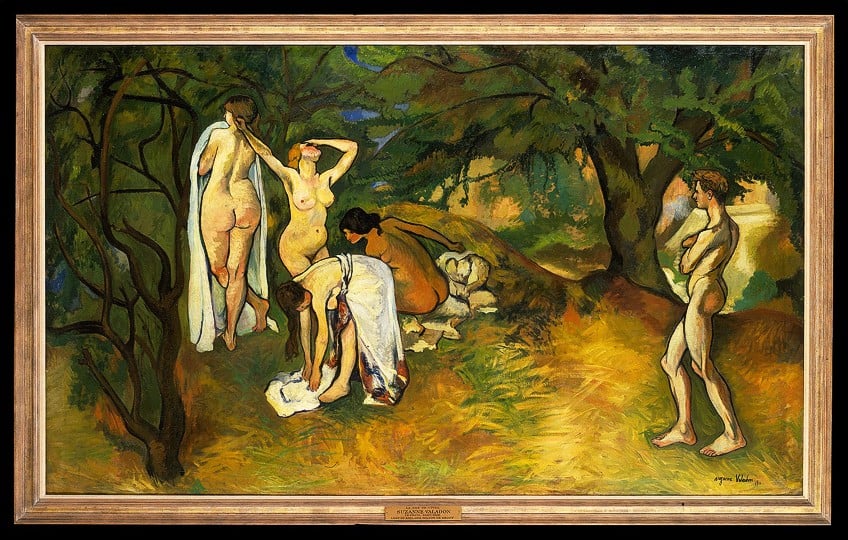
Valadon’s painting is also comparable to the theme of bathers in nature and the presence of the male figure is potentially an indicator of the male gaze cast, by Valadon, in the role of the object. This would mean that Valadon intentionally subverted the idea of the role of women in painting as an object and switched the representation of women into the active position (as opposed to the passive and often sexualized nature of the male gaze).
Georges Braque (1882 – 1963)
| Artist Name | Georges Braque |
| Date of Birth | 13 May 1882 |
| Date of Death | 31 August 1963 |
| Associated Movements | Cubism, Fauvism, Impressionism |
Georges Braque was a leading 20th-century French painter whose most famous works contributed to the development of Cubism. For years, Braque’s artworks were often mixed up with those of his contemporary, Pablo Picasso. While Braque began his artistic endeavors in Impressionism, he soon adopted the Fauvist style after witnessing the work of a group of artists called the Fauves in 1905.
The Fauves incorporated brilliant colors as a representation of emotion.

Braque eventually formed his style, which was a more subtle adaptation of the original Fauvist style. Braque was also influenced by Cézanne and Gauguin, after which he began creating a proot-Cubist style while collaborating with Picasso.
Braque is also famous for inventing the papier collé technique, which refers to the application of only paper to a flat surface.
Violin and Candlestick (1910)
| Date | 1910 |
| Medium | Oil on canvas |
| Dimensions (cm) | 61 x 50.2 |
| Where It Is Housed | San Francisco Museum of Modern Art, San Francisco |
Described as an embodiment of Analytic Cubism itself, this famous painting by Braque is a frequently referenced example of an artwork that showcases the adoption of fragmentation to depict three-dimensional objects. Braque described his use of this technique for this painting as a way to get “closer” to the object.
The refusal to use traditional Renaissance methods of painting an object is admirable in Braque’s work and provides an illusionary window for the viewer to explore other forms of representation of three-dimensional objects.
This painting was made during a period when Braque was obsessed with exploring form and stability, or perhaps the disruption of both. Braque employs a grid-like armature and earthy hues with starkly contrasting black lines to create this effect. By interrupting the presentation of still-life objects, Braque offers the viewer more than one angle of looking as opposed to a single vantage point.
Henriette-Hélène de Beauvoir (1910 – 2001)
| Artist Name | Henriette-Hélène de Beauvoir |
| Date of Birth | 6 June 1910 |
| Date of Death | 1 July 2001 |
| Associated Movements | Cubism, Modernism |
Henriette-Hélène de Beauvoir was one of the most popular French painters of the 20th century who was greatly influenced by the style of Cubism. De Beauvoir was also an advocate for equality for women and was established as the president of the center for battered women in Goxwiller, Strasbourg.
Throughout her artistic career, her works were well-received and caught the attention of the global art scene.

Many of her works were exhibited across Europe, the United States, and Japan. De Beauvoir was also the elder sister to the existentialist philosopher Simone de Beauvoir, who also shared Henriette’s passion for feminist activism.
Self Portrait (1955)
| Date | 1955 |
| Medium | Oil on canvas |
| Dimensions (cm) | 66 x 81 |
| Where It Is Housed | Private collection |
This is just one example of one of De Beauvoir’s most famous Cubist-inspired self-portrait paintings that illustrates the artist in a colorful arrangement of wide brushstrokes that appear to decrease in size and shape as it reaches the center of the painting to add detail to the artist’s face.
De Beauvoir cleverly makes use of a cool-toned backdrop of pastel-colored blocks to distinguish the subject in the foreground.
She paints herself with a light addition of warm tones in a similar fashion with narrower brush strokes. The colorful arrangement of Cubist brushwork sheds light on the character of the artist and this self-portrait can be seen as a bubbly reflection of De Beauvoir, as she perceived herself.
These famous French artists and their paintings have made a significant impact on the development of painting as an art form and demonstrate the domino effect of one art movement on another. Other famous French painters and paintings include the likes of Georges Seurat, Henri Matisse, Jean-Auguste Dominique Ingres, Henri de Toulouse-Lautrec, and Auguste Rodin.
Take a look at our French artists webstory here!
Frequently Asked Questions
Who Is the Most Famous French Painter of All Time?
Claude Monet is considered the most famous French painter of all time alongside Georges Seurat and Eugène Delacroix.
What Is the Most Famous French Painting?
The most famous French painting is Impression, Sunrise (1872) by Claude Monet.
What Is the Most Expensive French Painting?
Nafea Faa Ipoipo (1892) by Paul Gauguin is considered the most expensive French painting, having sold for $300 million.
Jordan Anthony is a Cape Town-based film photographer, curator, and arts writer. She holds a Bachelor of Art in Fine Arts from the University of the Witwatersrand, Johannesburg, where she explored themes like healing, identity, dreams, and intuitive creation in her Contemporary art practice. Jordan has collaborated with various local art institutions, including the KZNSA Gallery in Durban, the Turbine Art Fair, and the Wits Art Museum. Her photography focuses on abstract color manipulations, portraiture, candid shots, and urban landscapes. She’s intrigued by philosophy, memory, and esotericism, drawing inspiration from Surrealism, Fluxus, and ancient civilizations, as well as childhood influences and found objects. Jordan is working for artfilemagazine since 2022 and writes blog posts about art history and photography.
Learn more about Jordan Anthony and about us.
Cite this Article
Jordan, Anthony, “Famous French Painters and Paintings – The Top Parisian Painters.” artfilemagazine – Your Online Art Source. November 2, 2022. URL: https://artfilemagazine.com/famous-french-painters-and-paintings/
Anthony, J. (2022, 2 November). Famous French Painters and Paintings – The Top Parisian Painters. artfilemagazine – Your Online Art Source. https://artfilemagazine.com/famous-french-painters-and-paintings/
Anthony, Jordan. “Famous French Painters and Paintings – The Top Parisian Painters.” artfilemagazine – Your Online Art Source, November 2, 2022. https://artfilemagazine.com/famous-french-painters-and-paintings/.


